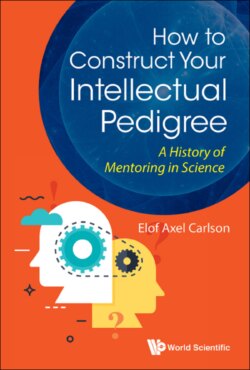Читать книгу How to Construct Your Intellectual Pedigree - Elof Axel Carlson - Страница 13
На сайте Литреса книга снята с продажи.
6Muller’s Intellectual Pedigree Through Morgan
ОглавлениеThomas Hunt Morgan (1866–1945) was born in Lexington, Kentucky, to a famous family (his father and brother led Morgan’s Raiders during the Civil War) and his maternal grandfather was Francis Scott Key. Morgan downplayed his genealogy and treated his students as colleagues. He died in Pasadena, California. He got his PhD in 1890 with William Keith Brooks but was more stimulated in his interests with invertebrate development by physiologist H. Newell Martin. Morgan’s PhD was on the embryology of sea spiders (picnogonids). He went to Naples and was influenced by the new German school of developmental mechanics (Entwicklungsmechanik). Morgan taught at Bryn Mawr and then joined the faculty at Columbia University where he founded the Fly Lab, using Drosophila to find X-linked inheritance and a phenomenon of crossing over within paired homologous chromosomes that accounted for the considerable recombination of traits during sperm or egg production. Morgan received the Nobel Prize in 1934 for his work. He moved to CalTech in 1928 and established it as a world class center for genetic research. Morgan made substantial contributions to embryology before he switched to genetics. He studied the regeneration of limbs and the production of twins and chimeras by experimental means. His switch to genetics came from his association with E. B. Wilson and his visit to Hugo DeVries in Holland who claimed he observed new species arising in fields of primroses (Oenothera lamarckiana). In addition to Muller, Morgan’s PhD and postdoctoral students included Fernandus Payne, A. H. Sturtevant, C. B. Bridges, C. C. Tan, Jack Schultz, George Beadle, and Otto Mohr.
